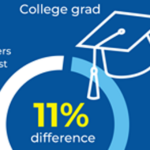Until we commit as a society to reducing poverty, educational equity will remain an elusive goal.
“One foot cannot stand on two boats.” — Chinese proverb
Under apartheid in South Africa, schools that served white students were funded at 10 times the level of schools that served Black students. When apartheid ended and funding was equalized, schools in affluent communities, now multiracial, had significant funding reductions.
Government officials were left with two choices: Ensure resource equality, which would risk the loss of affluent families to private schools, or permit private contributions to public schools to compensate for reduced funding after equalization. They chose the latter, believing it to be the lesser of two evils (Crouch, 2010).
School leaders in the U.S. face similar choices. They know that maintaining broad support for public education depends on the continued participation of middle- and high-income families. If these families leave the public education system, public schools will be perceived as second-rate options, and any hope of educational equity will be over.
The dilemma we face
Policies designed to encourage middle- and high-income families to stay in public schools are often inconsistent with policies to strengthen equity. Equity is defined here as the opportunity for students to attend schools that are integrated by income, race, and ethnicity. We might look away when affluent schools receive additional funding. However, we cannot look away when the inequity is so severe that it limits opportunities for millions of low-income children.
The problem begins with high concentrations of community and school poverty (Spector, 2019). More than 12 million U.S. students attend schools with poverty levels above 75% (National Center for Education Statistics, 2022a). Teachers in high-poverty schools can make an important difference in the lives of individual students, and many students beat the odds. However, neither the teachers nor the students can overcome the correlation between high concentrations of poverty and low average test scores (Ed100, n.d.). And test scores determine perceptions of whether schools are succeeding or failing.
Fair or not, families that have alternatives do not choose schools in areas with high concentrations of poverty. In many developing countries with high overall levels of poverty, middle- and high-income families have long chosen private education. Industrialized countries, however, often maintain broad support for public education. In the U.S., 90% of elementary and secondary students are enrolled in public schools (National Center for Education Statistics, 2022b). The long-term support of more affluent families, however, is precarious. As a result, education policies are designed to encourage these families to continue sending their children to public schools.
To attract and retain those families, districts generally downplay desegregation plans and boost selective schools and tracks — typically including gifted, honors, Advanced Placement, and/or International Baccalaureate courses and programs — that divide students (Vail, 2023). The results are classes with limited diversity, even if housed in diverse schools. The competition for admission to selective schools and tracks takes place on an uneven playing field, beginning with tutoring and cram courses primarily available to more affluent families. The selective schools and tracks, therefore, disproportionately benefit middle- and high-income students and provide an incentive for these families to remain in public schools. But these incentives come at a cost to students from low-income families, who are further isolated into separate schools and tracks.

Potential for reducing concentrated poverty
Many urban districts face poverty rates so severe that it’s impossible to significantly reduce the number of schools with high concentrations of poverty (Potter, 2022). Affluent students of all racial and ethnic groups who stay in urban public schools often attend selective schools. Some of these schools, like the School Without Walls High School in Washington, D.C. (Office of the State Superintendent of Education, n.d.), are racially and ethnically diverse. Others, like Stuyvesant High School in New York City (NYSED School Information Repository System, n.d.), have only minimal representation of Black and Latinx students. Either way, selective schools have lower poverty rates than the schools attended by the majority of students in their districts (New York City Department of Education, n.d.).
Suburban districts offer more opportunities for integration because they typically have heterogenous student populations and lower overall poverty rates. Many of these districts could design school attendance zones to minimize concentrated poverty (Asson et al., 2023). However, districts face threats from parents to leave public schools if these changes require middle- and upper-income families to leave their community schools and transfer to higher-poverty schools (Cano & Rankin, 2020; Rotberg, 2020).
Integration and segregation patterns in these districts also suggest that families support integrated schools as long as the schools their children attend are in their communities and the poverty levels at those schools remain moderate. It is not unusual for diverse districts to have a three-tier system: segregated schools with high concentrations of poverty in some neighborhoods, integrated schools with lower poverty rates in other neighborhoods, and schools with little diversity in the wealthiest neighborhoods because of the high cost of homes.
Consider, for example, Maryland’s Montgomery County, a large racially and ethnically diverse district with many integrated schools and long-standing affordable housing programs. Even in this context, 20% of the schools have Black and Latinx student enrollments of 80% or more, even though the combined enrollment of Black and Latinx students in the district is only 52%. These segregated schools also have among the highest poverty rates in the district, well above the overall district poverty rate of 34%. Schools in neighborhoods with lower poverty rates are more integrated by race and ethnicity (Asson et al., 2023; Rotberg, 2020).
The difference in opportunities between high-poverty and more affluent neighborhoods do not go unnoticed. Students and families in the high-poverty neighborhoods have protested their segregated schools. In response, Montgomery County is considering changes in school attendance zones to increase integration (Peetz, 2019, 2021). To date, the ensuing controversy has ensured that any changes would be minimal.
The burden of concentrated community and school poverty falls largely on Black and Latinx families in both urban and suburban districts. Despite the enormous gains made in the decades since the civil rights movement, large wealth gaps continue to limit the housing and, therefore, the school options of even relatively high-income Black and Latinx families. The median white family has more than eight times the wealth of the median Black family and almost five times the wealth of the median Latinx family (Kent & Ricketts, 2021). This is the result of discrimination and poverty — and, particularly in the case of Black families, a history of segregated federal housing programs and denial of mortgages in predominately Black neighborhoods. Because of these policies, Black families lost the opportunity to accumulate wealth and move to more expensive neighborhoods as housing prices rose (Rothstein, 2017). Today, 45% of Black students and 43% of Latinx students attend high-poverty schools, compared to 14% of Asian American students and 8% of white students (National Center for Education Statistics, 2022a).
We know families will support integrated schools if the schools are in their communities and poverty levels remain moderate. Therefore, if we want to give students the opportunity to attend integrated schools, we will need to go to the source of the problem by reducing concentrations of poverty.
Minority and immigrant families in other industrialized countries also face discrimination, concentrations of poverty, segregation, tracked programs, and separate schools (Dražanová, 2021; Faragau et al., 2020). The extent and nature of the problems differ among countries, as do the government policies. However, research conducted by the Stanford Center on Poverty and Inequality shows considerably less segregation in most European cities that had recent increases in immigration than in U.S. immigration gateway cities. The authors attribute this difference, at least in part, to concerted government efforts in Europe to strengthen integration through nonprofit and mixed-income housing rather than relying largely on market-based options, as in the U.S. (Lichter, Parisi, & de Valk, 2016).
No quick fixes
As long as poverty remains high, public school leaders will continue to balance their concerns about equity with their desire to maintain enrollment of middle- and high-income students. There is no lack of interest in reducing concentrations of poverty and increasing integration, but current efforts remain marginal. While desegregation initiatives might lead to limited changes in school attendance zones that affect a small number of students, high-poverty schools stay segregated. In some communities, advanced tracks have become open to more students; and some selective schools, like Thomas Jefferson High School for Science and Technology in Alexandria, Virginia, have revised their admissions process to be more inclusive (Liptak, 2022). But tracks and selective schools continue to advantage more affluent students.
Certainly, even the small changes make a difference. But we can expect major educational inequities to persist so long as current levels of concentrated poverty persist. School leaders will continue to have one foot on two boats. Families that have alternatives will continue to avoid schools with high concentrations of poverty as they have done time and time again. If we ignore these realities, our rhetoric about equity will be just words.
There are no quick fixes. However, we do have options. We know families will support integrated schools if the schools are in their communities and poverty levels remain moderate. Therefore, if we want to give students the opportunity to attend integrated schools, we will need to go to the source of the problem by reducing concentrations of poverty. That will require us to make difficult political decisions about social and economic policies — poverty reduction, employment, affordable housing, and access to higher education. Only then can we expect significant gains in educational equity.
References
Asson, S., Frankenberg, E., Fowler, C.S., & Buck, R.K. (2023). Attendance zones in the suburbs. Phi Delta Kappan, 104 (5), 11-17.
Cano, R.G. & Rankin, S. (2020, January 29). Parent resistance thwarts local school desegregation. The Associated Press.
Crouch, L. (2010). South Africa: Overcoming past injustice. In I.C. Rotberg (Ed.), Balancing change and tradition in global education reform (2nd ed., pp. 51-76). Rowman & Littlefield Education.
Dražanová, L. (2021) Breaking the cycle of poverty for a more social and inclusive Europe. The European Commission.
Ed100. (n.d.). Poverty and race: How do students’ backgrounds affect their school performance? (updated July 2022).
Faragau, B., Molard, S., Heras, N., Carey, T., Locati, F., & Wiering, D. (2020). Fighting child poverty in European cities: Lessons from cities for the EU Child Guarantee. Eurocities.
Kent, A.H. & Ricketts, L. (2021). Wealth gaps between white, Black, and Hispanic families in 2019. Federal Reserve Bank of St. Louis.
Lichter, D.T., Parisi, D., & de Valk, H. (2016). Residential segregation. Pathways (Special Issue 2016), 65-75.
Liptak, A. (2022, April 25). Supreme Court allows elite high school’s new admissions rules. The New York Times.
National Center for Education Statistics. (2022a). Concentration of public school students eligible for free or reduced-price lunch. U.S. Department of Education.
National Center for Education Statistics. (2022b). Fast facts: Public and private school comparison. U.S. Department of Education.
New York City Department of Education. (n.d.). DOE data at a glance.
NYSED School Information Repository System. (n.d.). Stuyvesant High School enrollment, 2019-20.
Office of the State Superintendent of Education. (n.d.). DC school report card: School Without Walls High School.
Peetz, C. (2019, May 16). It won’t change until we address it. Bethesda Magazine.
Peetz, C. (2021, May 17). A look back at the MCPS countywide boundary analysis. Bethesda Magazine.
Potter, H. (2022). School segregation in U.S. metro areas. The Century Foundation.
Rotberg, I.C. (2020). Crossroads: Integration and segregation in suburban school districts. Phi Delta Kappan, 101 (5) 44-49.
Rothstein, R. (2017). The color of law: A forgotten history of how our government segregated America. Liveright Publishing.
Shapiro, E. (2021, April 29). Only 8 Black students are admitted to Stuyvesant High School. The New York Times.
Spector, C. (2019, September 23). School poverty—not racial composition—limits educational opportunity, according to new research from Sanford. Stanford News.
Vail, K. (2023). Loudest voices and unequal opportunities in the suburbs: A conversation with John B. Diamond. Phi Delta Kappan, 104 (5), 24-28.
This article appears in the March 2023 issue of Kappan, Vol. 104, No. 6, pp. 40-43.
ABOUT THE AUTHOR

Iris C. Rotberg
Iris C. Rotberg is a research professor of education policy at the Graduate School of Education and Human Development at The George Washington University, Washington, DC. She is the editor, with Joshua L. Glazer, of Choosing Charters: Better Schools or More Segregation?











